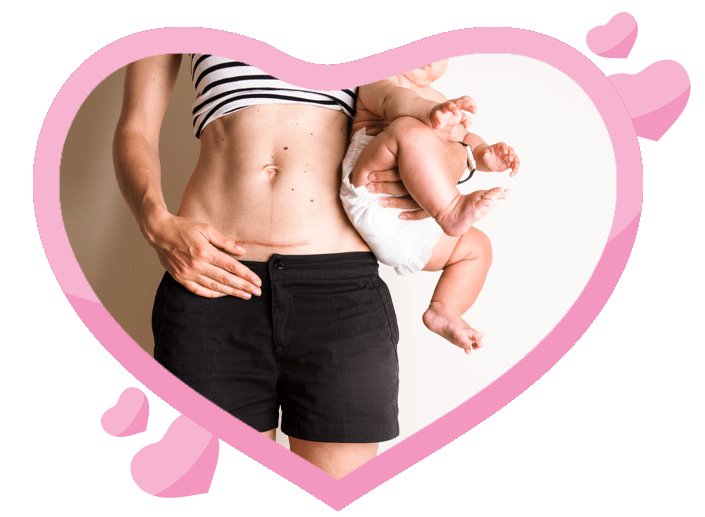Breastfeeding after C-Section; What to Expect?
Tips to make the nursing process after C-section easy.

What you should know about breastfeeding after C-section.
Many women have to go through C-section to have their babies, which indubitably affects breastfeeding. The effect of the procedure on breastfeeding is tied to the type of anesthesia employed.
General anesthesia would leave the mother and child sleeping for a while after the process, meaning that breastfeeding would be paused till both are awake. If it is epidural anesthesia, mothers will be able to breastfeed their babies in the operating room.
If you would be having a C-section, it is a great idea to take preparatory steps before the day. In this article, you will learn how a C-section affects your breastfeeding, the things you can do to make it easy for yourself and your baby, and the importance of seeking support after the procedure
Delay in milk production
If you’ve had a C-section to deliver your baby, you might experience a delay in milk production. Don’t panic or worry; many mothers who have given birth using this means have also reported experiencing the same thing. In comparison, it is not the same for women who have a vaginal delivery.
You would have to make extra effort to get your milk flow on track to meet your baby’s demands. One remedy suggested to try out upon delivery is cuddling. Cuddling your baby skin-to-skin can help stimulate your body to produce the hormones needed to trigger the flow of breastmilk once again. The intimacy is powerful.
Post-delivery medical needs
Your body goes through a lot during a C-section, and you can expect to be given more medical care after delivery than if you had your baby via vaginal delivery. A urinary catheter will be put in place after surgery, which you can expect to see taken out on the first day after surgery.
You will be brought to a recovery area where a nurse would attend to you. Your blood pressure will be monitored. Your heart rate and the amount of vaginal bleeding will also be observed. Your uterus will go through occasional checks to make sure it is growing firm. When you are ascertained to have recovered successfully, you will be taken out of recovery.
Emotions
Expect yourself to go through a rollercoaster of emotions after surgery. During the first week, you might feel exhausted, sad, anxious, and worried. These emotions might be more intense if this is your first baby. You would find yourself expressing to anyone who cares to hear about your fear over raising your child. Also known as the ‘baby blues,’ a scientific study shows how hormonal changes are irresponsible.
Postpartum depression might set in, or you might find yourself consumed by anxiety. You are not alone. A lot of women in your situation went through something similar. Speak to your partner about your fears if you have a partner. If you do not, take anti-depressants and go for therapy.
Tips for successful nursing
Here are some tips you can follow to overcome the hurdles that come with breastfeeding after a C-section.
Start early and frequently
Now that you know there can be a delay in milk production that can render you incapable of breastfeeding your baby upon delivery, one thing you can do to hurry up the milk flow is to start early.
If you’ve had epidural or spinal anesthesia, you will be able to breastfeed right in the operating room, and that is when you should begin. If you can’t breastfeed right away, do the minimum of bringing your baby close to your skin to prime up milk production so when you do have the opportunity to feed your baby, you would find it easy.
Learn to hand express
You might be lucky to know way ahead of time that you would be having a C-section, and that is good. If it sprung upon you, you should also follow the advice to hand express. Hand expressing means pumping milk with your hands before childbirth.
At about 36 weeks of pregnancy, you can hand express colostrum into a syringe that can be stored for later use. Hand expressing is also something you can do to encourage milk flow. Instead of depending on the baby to suckle out their milk, you can hand express to speed up milk flow.
Pumping Bra
Pumping bras are an essential accessory for lactating mothers. It is extra-helpful because it allows for a hands-free approach to pumping breast milk. It holds the breast pump flanges in place while using the breast pump. When choosing a pumping bra, pick a comfortable one, that has extra hooks to accommodate your changing size, and has padding to absorb milk leakage.
Pumping breastmilk can be a little embarrassing, more so if your workplace does not provide a separate room for lactating mothers. You should wear clothes that are easy to pull off and on as fast as you need them. Two-piece outfits with a top and a bottom are the most useful. Nursing tanks should also be in your pumping armory. They are easy to snap off when you need to pump or breastfeed. If you wouldn’t want to change how you dressed, a nursing cover is an appropriate fabric you should possess.
Comfortable Breastfeeding Positions
Your baby’s milk has an expiry period. If you pump at work to take home to your baby – in 4 hours, that milk would no longer be suitable. A milk cooler stops that from happening. It cools your milk to a temperature that makes sure it is still viable for the baby when you get off work.
Breastfeeding after your C-section can be painful. The incision site will cause you pain, and your uterus wouldn’t do you any favors. There is the IV line, which you have to worry about too. To help with the discomfort and help the milk down, there are several positions you can try that will help. Here are two you can try:
1. Cradle Hold: If you ever cradled a doll, it is the same thing; you would just be cradling a human life, therefore dropping the baby is now allowed. This position should keep the baby far from the incision on your belly, protecting it from pressure.
2. Side-Lying Position: Lying on your back the entire time may get frustrating. This position offers relief from having to lie on your back. All you have to do is lie on your side, supporting yourself with an elbow while your baby lies in front of your breasts. If you have to, place a pillow under your baby to help it up to your breast. The baby would only have access to one breast except you switch directions.
Avoid Supplements
Breastfeeding after a C-section is a different situation from other forms of delivery. You are not alone in whatever struggle comes after the surgery. Exercise some patience and seek support whenever you feel overwhelmed by all of it.
Bottom Line
Pumping is stressful, messy, and inconvenient. However, these devices help to make it a little less of that. If you want to keep breastfeeding your baby when you resume work, you need them.
More For You!
Baby Gear
- Best Changing Table
- Best Strollers
- Best Cribs
- Best Car Seats
- Best Essentials Checklist
Game On Mommy
© Copyright 2020 by Gameonmommy.com. All rights reserved. We are a participant in the Amazon Services LLC Associates Program, an affiliate advertising program designed to provide a means for us to earn fees by linking to Amazon.com and affiliated sites.
Your body goes through a lot during a C-section, and you can expect to be given more medical care after delivery than if you had your baby via vaginal delivery. A urinary catheter will be put in place after surgery, which you can expect to see taken out on the first day after surgery. You will be brought to a recovery area where a nurse would attend to you. Your blood pressure will be monitored. Your heart rate and the amount of vaginal bleeding will also be observed. Your uterus will go through occasional checks to make sure it is growing firm. When you are ascertained to have recovered successfully, you will be taken out of recovery.





